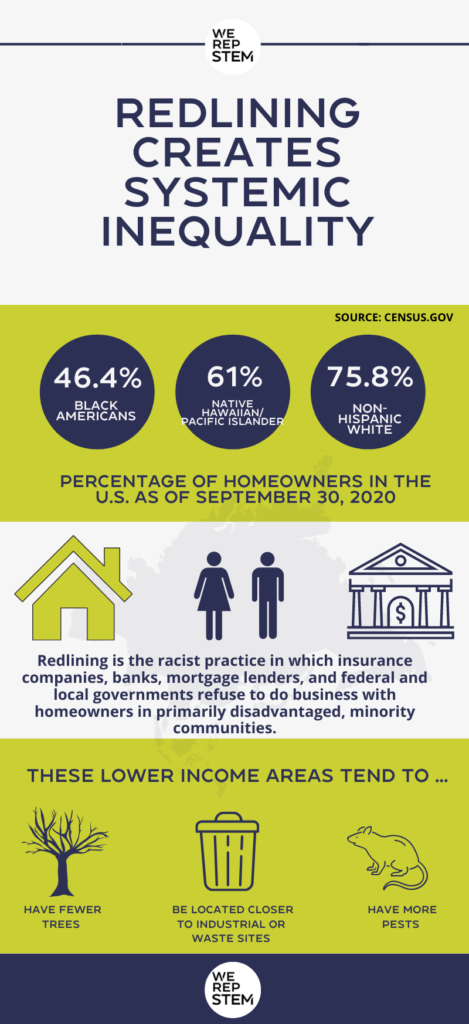The link between systemic racism, pollution, and test scores

Last month, the U.S. National Association of Realtors (NAR) issued a public apology for the role it has played in perpetuating systemic racism. For decades, organizations in Canada and the U.S., including the NAR, have openly engaged in the racist and segregative practice of redlining, in which insurance companies, banks, mortgage lenders, and federal and local governments refuse to do business with homeowners in lower-income, minority-led communities.
This creates a cycle of exclusion by marking these areas as “undesirable” — steering away potential developers, businesses, and other valuable urban resources that provide children with tools that help them thrive physically, mentally, and academically.
The NAR says it is trying to right past wrongs by implementing a fair housing program and pledging to work alongside national groups to address the persistently low rates of homeownership among Black Americans. According to U.S. Census data, about 46.4 per cent of Black Americans owned a home in the U.S. as of September 30, 2020, compared to 75.8 per cent of white Americans — a lasting legacy of racist practices.
Another side effect of decades-long discrimination becomes evident upon closer inspection of the look, feel, and location of redlined communities.
Studies have shown there tend to be fewer trees in racially-minoritized neighbourhoods in major U.S. cities, and they are more likely to be situated near industrial or waste disposal sites than wealthier, majority-white neighbourhoods.
The location of lower-income communities, coupled with a lack of trees, has contributed to warmer localized temperatures, more pollution, less biodiversity, and a higher incidence of disease-carrying pests that have evolved to survive harsh environments.
And now, a new study has found a link between exposure to pollution and test scores, particularly in segregated neighbourhoods.
The new paper examines the impact of “peak” air pollution events, i.e., 24-hour spikes of high concentrations of fine particulate matter (PM2.5), which is responsible for hazy air pollution, in Salt Lake City, Utah.
Researchers found more frequent exposure to air pollution was associated with reduced math and English language arts test scores for third graders in all schools across Salt Lake County during the 2016-2017 academic year.
And while peak exposures had a stronger effect on lower math proficiency in ‘socially advantaged’ schools, children in lower-income neighbourhoods were exposed to more pollutants overall.
“The study highlights the environmental injustice of Salt Lake County’s air pollution problem,” reads a statement by the study’s authors.
“Schools with a higher proportion of students of colour and from households experiencing poverty were exposed to higher mean concentrations of fine particulates and more peak pollution days than were schools serving middle- to upper- class and predominately white students.”
The authors of the study are calling on legislators to advance initiatives that protect children from exposure to air pollution, including better air filtration in the short term and tightening federal air pollution standards in the long term.
“Here, with constant air quality issues throughout the seasons, we need to increase awareness about air pollution exposures,” lead author Casey Mullen said in a statement.
“This is a conversation everyone should be having — people need to be informed about what’s at stake.”
An August review paper on redlining and urban biodiversity suggests another way legislators could reduce pollution by imploring scientists researching urban life to stop focusing on wealthier areas and overlooking the possibility of differences in neighbourhoods of different income levels.
“I hope many of my senior colleagues would start to rethink how they do their science,” lead author Christopher Schell, an assistant professor of urban ecology at the University of Washington Tacoma, said in a statement.
“And for those scientists coming up, that this gives them the platform to say: ‘No, this is a legitimate question: How do we reduce, minimize, abolish racism in America?’”
The authors argue environmental issues should be re-examined to encompass societal problems.
Creating affordable housing, for example, could result in less turnover and fewer construction areas, leading to more ecological stability. Equitable access to green spaces could also help with plant and animal biodiversity and, in turn, the environment.

To embed this image on your site, copy the following code:
<p><strong>Please include attribution to www.werepstem.com with this graphic.</strong><br /><br /><a href='https://werepstem.com/2020/11/27/national-realtor-association-apologizes-for-enabling-systemic-racism/'><img src='https://werepstem.com/wp-content/uploads/sites/2/2020/11/00redlining-1-703x1536.png' alt='Redlining and systemic inequality' width='800' border='0' /></a></p>

Support We Rep STEM and help us create more rad content. This includes hiring and compensating contributors, because we believe everyone should be paid for their work.
